new posts in all blogs
Viewing Blog: April Pulley Sayre Children's Book Author, Most Recent at Top
Results 1 - 25 of 192
Website for April Pulley Sayre, Award-winning Children's Book Author
Statistics for April Pulley Sayre Children's Book Author
Number of Readers that added this blog to their MyJacketFlap: 1
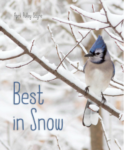
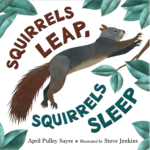
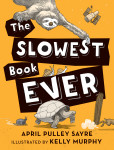
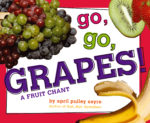
Happy to announce four books for 2016. Go, Go, Grapes board book debuted in the Little Simon Classic Board Book line in Feb. The Slowest Book Ever, (Boyds Mills Press) came out in April. In October get ready for Best In Snow (Beach Lane/S&S) a photographic sister for Raindrops Roll. In November, my next work with Steve Jenkins/Holt, Squirrels Leap, Squirrels Sleep will jump onto bookstore and library shelves.
 “The Antidote for a Hurried Childhood” was what the Huffington Post called my middle grade nonfiction book, The Slowest Book Ever (Boyds Mills Press, release in April, 2016) in a sneak peek article late by Vicki Cobb last year. This book has line drawings by the fabulous Kelly Murphy. It’s reviewed by the esteemed School Library Journal in their upcoming (February) issue. The wonderful Junior Library Guild will be sharing it with their subscribers in July, 2016.
“The Antidote for a Hurried Childhood” was what the Huffington Post called my middle grade nonfiction book, The Slowest Book Ever (Boyds Mills Press, release in April, 2016) in a sneak peek article late by Vicki Cobb last year. This book has line drawings by the fabulous Kelly Murphy. It’s reviewed by the esteemed School Library Journal in their upcoming (February) issue. The wonderful Junior Library Guild will be sharing it with their subscribers in July, 2016.
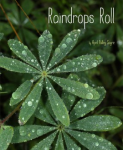
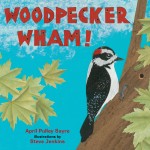
Raindrops Roll and Woodpecker Wham were both named ALA Notables! So thankful to the folks who put time and energy into serving on the ALA Notable Committee and also those on the NCTE Orbus Pictus committee, which recognized Raindrops Roll. This means a lot, encourages my work (and Steve Jenkins’ work on Woodpecker Wham), and hopefully helps readers find these books. There are lots of yummy books on the Notable List this year, check it out: http://www.ala.org/alsc/awardsgrants/notalists/ncb.
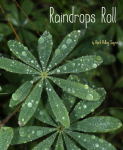 Floored and thrilled that RAINDROPS ROLL was just named
Floored and thrilled that RAINDROPS ROLL was just named
An Orbis Pictus Recommended Book by NCTE, the National Council of Teachers of English. This award for the best nonfiction of 2015 considers ALL the nonfiction books, K-8. They choose a winner, five honor books, and eight recommended books. (Bronze award sticker for recommended.)
An Outstanding Science Trade Book for 2015 by NSTA, the National Science Teachers Association. I’m so excited that folks are loving not only the words but also the photos I took. I work hard to make sure my photos bring wonder and science content so their approval means a lot.
One of the 12 Best Informational Picture Books of the year according to Kirkus. It’s also honored in what is my favorite award category name ever: The Best Picture Books For the Sense-of-Wonder Shelf, again by Kirkus. Doesn’t every library and classroom and home need a “Sense-of-Wonder” shelf? Isn’t that what’s it all about? I’m going to rush out and read the other titles, fiction and nonfiction. As many of you know, even when I was college I identified my goal in life as “helping people feel a sense of wonder in nature.” Feels like life moment achieved that my book fit in such a category.
I am updating my website this week so things may look a little wacky. Don’t worry. The content is still here but the formatting is definitely going to be wild during the remodel.Thanks for your patience.
 Woodpecker Wham! was released today by Henry Holt. So excited to have this third collaboration with illustrator Steve Jenkins, thanks to Holt. (You can support our work to share nature and science with kids via our other two titles, as well: Vulture View and Eat Like a Bear.)
Woodpecker Wham! was released today by Henry Holt. So excited to have this third collaboration with illustrator Steve Jenkins, thanks to Holt. (You can support our work to share nature and science with kids via our other two titles, as well: Vulture View and Eat Like a Bear.)
Hope to see some of you at School Library Journal’s Day of Dialog in NYC where I’ll be on a nature books panel with Paul Fleischman, Wendell Minor, Louis Sachar, and Anita Silvey.
Book love! A great review in Bookpage and a third star for Raindrops Roll (Beach Lane/S&S), this time in Publisher’s Weekly. Woodpecker Wham, with Steve Jenkins, will be released May 15 and was recently reviewed by Kirkus. I’m just back from three weeks photographing creatures in FL beaches and wetlands. Can hardly wait to share the FL photos with you, readers. This year I’m going to update my website to make it more interactive. In the meantime, “Like” my facebook author page April Pulley Sayreand from there I’ll keep you updated on when the new interactive site is ready. Other recent blog reviews and interviews on Richie’s Picks, Seven Impossible Things Before Breakfast, and Think Quick Interview.
By: April Sayre,
on 2/16/2015
Blog:
April Pulley Sayre Children's Book Author
(
Login to Add to MyJacketFlap)
JacketFlap tags:
Books,
poetry,
picture books,
Birds,
Nonfiction,
Steve Jenkins,
onomatopoeia,
alliteration,
Picture Books - Nonfiction,
Symbiosis,
Featured Resource,
Add a tag

Illustrated by Steve Jenkins, Henry Holt Books for Young Readers, May 12, 2014.
“Repetitive onomatopoeic sounds such as ‘CHOP, CHIP, CHOP’ and ‘BONK-BONK-BONK’ combine with plentiful alliteration to make the simple verses come alive . . . Attractive and surprisingly informative, this should join the duo’s Eat Like a Bear (2013) on every preschool and primary nature shelf.”
-Kirkus

Text and photos by April Pulley Sayre. Beach Lane Books/S&S, January, 2015. Ages 3-8.
“With lyrical words and striking images, a poet, photographer, and veteran natural history writer celebrates rain . . . Preschoolers can appreciate the poem and pictures, but middle graders will want the facts in the concluding ‘Splash of Science’ . . . Wonder-full in every way. -Starred Review, Kirkus
“In playful rhymes and breathtaking nature photography, Sayre offers a dramatic examination of a rain shower as droplets soak birds, roll down pumpkins, dot the backs of insects, and muddy the forest floor.”
-Starred Review, Publisher’s Weekly
“This attractive work is also ideal for read-alouds and an easy entry for students delving into nonfiction reading, especially in poetry or science units.”
-Starred Review, School Library Journal
“For over three decades, I’ve been immersed in an ocean of children’s picture books, reading and reading aloud countless numbers of them. With all that, I’m astounded by the quality of the photographs in RAINDROPS ROLL . . . When we talk about exposing children to nonfiction at an early age, this is the kind of book we should be advocating.”
-Richie’s Picks
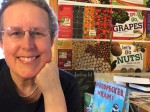 Greetings from here at my desk, Jan 5, 2015! “. . . we read and are refreshed by such beauty and natural simplicity,” says the Wall Street Journal of my just released photo-illustrated book, Raindrops Roll. It was favorably reviewed in a Wall Street Journal article Jan 3, 2015, page C9. How wild is that? For another lovely review, see BookPage. There Julie Danielson says: “With expertly crafted, economical text and vivid photographs, April Pulley Sayre brings readers a tribute to the wonders of rain itself.” 2015 is shaping up to be a great year. I’m busy writing and out in nature doing photography for picture books and middle grade books under contract. In addition to Raindrops Roll, out now from Beach Lane/S&S, I’m also looking forward to Woodpecker Wham, illustrated by Steve Jenkins, which will be released by Henry Holt on May 12, 2015. My husband’s recent work, Kaufman Field Guide To Nature of the Midwest, coauthored with the Kaufmans, will be out from Houghton Mifflin in late April. We so appreciate your support, as readers and educators. Your buying our books and recommending them to others allows us to do this healthy, joyful work of exploring and sharing nature, science, and playful language. Happy 2015, friends!
Greetings from here at my desk, Jan 5, 2015! “. . . we read and are refreshed by such beauty and natural simplicity,” says the Wall Street Journal of my just released photo-illustrated book, Raindrops Roll. It was favorably reviewed in a Wall Street Journal article Jan 3, 2015, page C9. How wild is that? For another lovely review, see BookPage. There Julie Danielson says: “With expertly crafted, economical text and vivid photographs, April Pulley Sayre brings readers a tribute to the wonders of rain itself.” 2015 is shaping up to be a great year. I’m busy writing and out in nature doing photography for picture books and middle grade books under contract. In addition to Raindrops Roll, out now from Beach Lane/S&S, I’m also looking forward to Woodpecker Wham, illustrated by Steve Jenkins, which will be released by Henry Holt on May 12, 2015. My husband’s recent work, Kaufman Field Guide To Nature of the Midwest, coauthored with the Kaufmans, will be out from Houghton Mifflin in late April. We so appreciate your support, as readers and educators. Your buying our books and recommending them to others allows us to do this healthy, joyful work of exploring and sharing nature, science, and playful language. Happy 2015, friends!



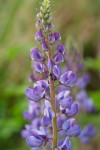 Raindrops Roll comes out with Beach Lane/S&S on Jan 5, 2015. Each photo I took has a special meaning to me and some have hidden creatures in them. So this blog covers the behind-the-scenes secrets and science. For instance, the droplet-covered leaves on the cover are lupine. That’s the same kind of plant made famous by the children’s book, Miss Rumphius, by Barbara Cooney. The plant produces a tall spike of bluish/purplish flowers. In Indiana, my husband planted several native lupine plants in small flower beds he created. Each year the plants flowered and formed pods. The pods dry and fling seed out of the flower beds. Those plants sprouted in our lawn. My husband mowed around them so the flower bed became bigger and bigger. So, now we, too, have plenty of lupine and the seed pods. To see one of seed pods, look through the book. Hint…it’s not just seeds that “fly.” (By the way, there’s a tiny fly in the front cover photo. Can you find it?)
Raindrops Roll comes out with Beach Lane/S&S on Jan 5, 2015. Each photo I took has a special meaning to me and some have hidden creatures in them. So this blog covers the behind-the-scenes secrets and science. For instance, the droplet-covered leaves on the cover are lupine. That’s the same kind of plant made famous by the children’s book, Miss Rumphius, by Barbara Cooney. The plant produces a tall spike of bluish/purplish flowers. In Indiana, my husband planted several native lupine plants in small flower beds he created. Each year the plants flowered and formed pods. The pods dry and fling seed out of the flower beds. Those plants sprouted in our lawn. My husband mowed around them so the flower bed became bigger and bigger. So, now we, too, have plenty of lupine and the seed pods. To see one of seed pods, look through the book. Hint…it’s not just seeds that “fly.” (By the way, there’s a tiny fly in the front cover photo. Can you find it?)

Our lupine bed

A lupine leaf with rain on it
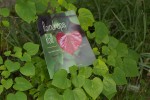
A small redbud tree
Raindrops Roll Inside Cover
The big heart-shaped leaf is a young leaf of a Redbud tree I planted. Every year leaf cutter bees cut pieces of this tree. But you’ll have to wait for another book to see those cut leaves!
Pages 3-4 The frog
This is a a cup plant, which is a native prairie plant. My husband, Jeff Sayre, took the photo of the gray tree frog in that plant. That year our cup plants had lots of tiny red insects eating them so these leaves are very chewed up and brown. The exoskeletons of the insects are left on the undersides of the leaves.
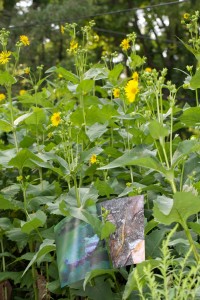
The cup plants where the frog was sitting.
Pages 5-6 The dark sky/bird
The bird is a mourning dove.
Pages 7-8
The insect inside the red lily is a juvenile katydid. Katydids look much different as adults.
The fly is inside a lupine pod. The first time I photographed this plant I was just trying to take a photo of the pod. But when I went indoors to look at the photo on the computer, as is often the case, I saw something else—this time, the fly hiding in the pod. So I ran back outside to photograph it more clearly. FYI: The orange flower behind it is not a lupine. It is a butterfly weed, a kind of milkweed that monarch caterpillars eat.
Pages 9-10
Those leaves are oak leaves right outside our house. I actually took the photo from the back window of our house so I was sheltered as it poured rain.
Pages 11-12
This bird is a bluejay. Bluejays, wet with rain, look gray. That’s because their blue color is a structural color, caused by the microscopic structure of the feathers. When rain wets the feathers, they do not bounce light the same way, so they do not look blue. They look gray. (Things that have pigmented colors, instead of structural feathers, would still look brighter blue even when wet.)
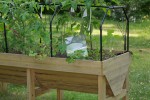 Pages 13-14
Pages 13-14
This insect is camouflaged to look like a leaf. It is an adult katydid. (A juvenile katydid appears elsewhere in the book. Not sure they are the same katydid species but they are both katydids.) One of the famous “sounds of summer” is actually made by katydids rubbing their wings together to create their call at night. It sounds a bit like katy-did, katy-did! See that pumpkin? It’s photographed at the South Bend Farmer’s Market where I photographed Rah, Rah, Radishes: A Vegetable Chant; Go, Go, Grapes: A Fruit Chant! and Let’s Go Nuts: Seeds We Eat. One day when I was at the market it rained. I ran outside to photograph a rainbow but then realized all the vegetables were washed by rain so I photographed this pumpkin, and others, too.
Pages 15-16
This is a tiger lily plant. Raindrops make little noises as they splash against the broad, hollow plant stem. Look for a tiger lily flower later in the book. Can you find it?
Pages 17-18
This is a salamander. Like most frogs, most salamanders need watery areas to lay their eggs. So rain is important in their lives! I photographed this one in southern Illinois.
Page 19-20
This plant has waxy leaves that repel water. So the water “beads up” on the plant.
Pages 21-22
This rainstorm water was gushing down a little trail in southwestern Michigan, near where I live.
Pages 23-24
This cabbage white butterfly inspired the book. I took a photo of it and when I looked at it on the computer, I was amazed to see the raindrops clinging to its head and legs. Soon, I became obsessed with photographing raindrops on things.
Cabbage white butterflies do, indeed, lay eggs on plants in the cabbage family.
Pages 25-26
Notice all the different sizes of raindrops on this daisy. When two water droplets are so close together that they touch, they usually join to form a single, larger droplet.
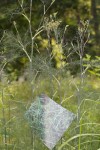
Pages 27-28
These droplets are on an herb called bronze fennel. It is a feathery green/brown/gray plant. When you crush its thin, spiky leaves, they smell like licorice. Black swallowtail butterflies lay eggs on this plant so it can be good for wildlife in northeastern gardens. But in other places, such as southern California, where the winter doesn’t kill it back, this plant can be a pest. It is invasive. It escapes into wild areas and grows thickly, outcompeting native plants and endangering habitats.
Pages 29-30
This is a leaf of a member of the cabbage family.
Pages 31-32
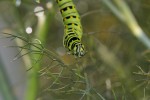 This is a black swallowtail caterpillar. The one in the book is munching dill flowers. This one is munching fennel.
This is a black swallowtail caterpillar. The one in the book is munching dill flowers. This one is munching fennel.
The flower with “dots” of rain on it is lantana, a popular landscaping plant that attracts butterflies.
Look for a terrific reflection of the entire stem in the raindrop near “drip!”
Pages 33-34
Remember the tiger? On the left page is a closeup of a tiger lily plant.
What needs wet areas? Moss! Underneath the slug is moss. This slug was photographed in Ohio.
What comes after rain? Mushrooms! A few days after heavy rains, mushrooms may begin to push up from the ground. The yellow ones in this photo are called “Yellow Earth Tongues.” They were photographed at a wild area near Fernwood Botanical Garden in Michigan.
Pages 35-36
This raindrop is on an evergreen conifer. Evergreen means it does not drop its leaves all at once. Conifers bear cones. The shape of the entire branch is reflected in the raindrop. The two rectangular flashes on my camera are also in the raindrop image.
Pages 37-38
Hundreds of tiny spheres of water formed on the spikes of this plant after it rained.
On the right page, sticking out of this beautiful plant, is a hidden creature. An earwig!Can you find it?
Pages 39-40
This web is decorated by raindrops. But on some mornings you may see spider webs covered with droplets not from rain, but from dew. Dew-covered webs sparkle in the morning sunlight. They’re often nicknamed “fairies’ washing” because people imagine fairies would wear such sparkly garments and put them out to dry on the shrubs and grasses.
Pages 41-42 This bumblebee is feeding at a wild senna, a midwestern tallgrass prairie plant.
Pages 43-44 The flowers on the copyright/acknowledgments page are actually cup plant flowers. Do you remember where else you’ve seen the cup plant in the book?
(The frog was in it at the beginning!)
Back Cover This is a grackle in the rain. If you see a flock of blackish birds some of them may be grackles. Grackles and red-winged blackbirds often travel in flocks together. Some grackles are brownish. Some adult male grackles look black in certain light yet in other light they are bronze, green, and purple, like this one in the rain.
Are all the raindrops in the book real? YES. Many times, as I waited for another rainstorm in order to take a certain photograph, someone would say, “Why don’t you just spritz it with some water from a bottle?” Nope. Not the same. I would know. And I don’t know how such droplets would differ from what is presented when raindrops fall and land on plants and animals. Besides, nonfiction should be real—and manmade raindrops would be fake to me.

Finally, here’s a photo that we considered for the book but did not go in. It’s a rainbow…eight feet off the ground in my backyard! It rained in my backyard while it was still sunny in the front yard and this tiny rainbow formed for just a few minutes.
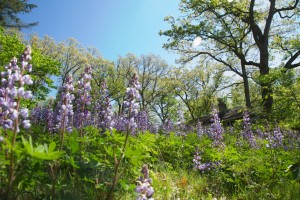
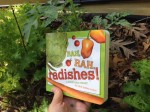 Rah, Rah, Radishes! becomes a board book in the Little Simon Classic Board Book line on July 15th! In 2015, look for Woodpecker Wham illus by Steve Jenkins (Holt )and my photo-illustrated Raindrops Roll (Beach Lane/S&S.)
Rah, Rah, Radishes! becomes a board book in the Little Simon Classic Board Book line on July 15th! In 2015, look for Woodpecker Wham illus by Steve Jenkins (Holt )and my photo-illustrated Raindrops Roll (Beach Lane/S&S.)
I am taking a speaking sabbatical through May 2015. So I won’t be scheduling any conferences or school visits during that time. If you are interested in future visits, contact me in March 2015 when I will start booking my schedule once again. Here’s a recent article about my work in Huffington Post: http://www.huffingtonpost.com/vicki-cobb/arousing-a-childrens-nonfiction_b_4859905.html
Bank Street Books had both Eat Like a Bear and Here Come the Humpbacks! on their best-of-the year lists. Hurray! Happy summer, everyone!
Portland Review has great coverage of Here Come the Humpbacks! http://portlandbookreview.com/tag/april-pulley-sayre/
Eat Like a Bear in Booklinks http://poetryforchildren.blogspot.com/2014/04/book-links-nonfiction-monday-meets.html
Kids & veggie books? See http://www.babybooknook.blogspot.com
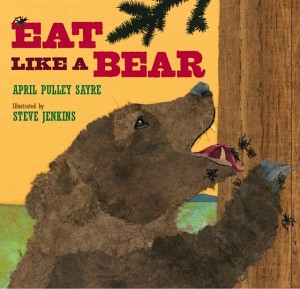 Raising my bowl of blueberries this morning to illustrator Steve Jenkins. Our book, Eat Like a Bear, which received three starred reviews, was named an ALA (American Library Association) Notable Book for 2014! It is a huge honor to be chosen for recognition by the ALA Notables Committee—especially in a year with such a great crop of books. By tradition, the list also includes winners from ALA award categories, too. Steve and I have three more projects in the works. Next up is Woodpecker Wham.
Raising my bowl of blueberries this morning to illustrator Steve Jenkins. Our book, Eat Like a Bear, which received three starred reviews, was named an ALA (American Library Association) Notable Book for 2014! It is a huge honor to be chosen for recognition by the ALA Notables Committee—especially in a year with such a great crop of books. By tradition, the list also includes winners from ALA award categories, too. Steve and I have three more projects in the works. Next up is Woodpecker Wham.
See my interview with Kirkus Reviews.com Julie Danielson of Seven Impossible Things Before Breakfast.
Preschool teachers rock! This teacher’s joy lifts my spirits every time I watch the video. While signing Rah, Rah, Radishes and Go, Go, Grapes last year in Atlanta, I met this fabulous teacher who agreed to share how she gets the 4-year olds in her class to try foods. The video is on my youtube channel. Jeff and I have also posted some of our nature clips on our Sayre Nature Youtube Channel.

“Sayre and Jenkins follow Vulture View (2007) with a similarly excellent study of brown bears that’s in equal parts poetic and enlightening.” -Kirkus, starred review.
ALA (American Library Association) Notable Book 2014
Smiling. At its conference NSTA announced its Outstanding Science Trade Books and both Eat Like a Bear and Here Come the Humpbacks were on the list! Richie’s Picks reviewed Eat Like a Bear here. I blogged about common core and photography on INK this month. I was asked to be a picture book champion so during the last week of November my short blog about picture books will be on the www.picturebookmonth.com website. ”Here Comes the Humpbacks destined to be an early learner favorite” says Chicago Now. Hope they’re right. Are you folks enjoying this cool Fall weather? You’ll find me photographing leaves, leaves, leaves!
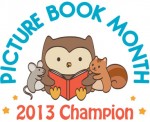 I’m honored to be a Picture Book Champion this year. See the calendar, essays, and activities this robust group has planned for November, 2013: www.picturebookmonth.com
I’m honored to be a Picture Book Champion this year. See the calendar, essays, and activities this robust group has planned for November, 2013: www.picturebookmonth.com
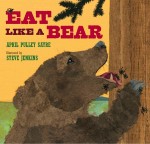 All week long I will be trying to eat like a bear to celebrate, well of course, my new book with Steve Jenkins and Henry Holt Books for Young Readers: Eat Like a Bear! To follow my adventures, “Like” my facebook author page. Wait ’til I go for some moths, ants, and bison later this week. That should be interesting. Currently working on stems, berries, roots, and tubers.
All week long I will be trying to eat like a bear to celebrate, well of course, my new book with Steve Jenkins and Henry Holt Books for Young Readers: Eat Like a Bear! To follow my adventures, “Like” my facebook author page. Wait ’til I go for some moths, ants, and bison later this week. That should be interesting. Currently working on stems, berries, roots, and tubers.
.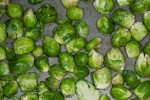
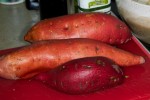
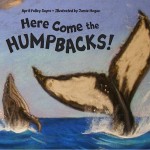 SB&F (Science Books and Films) October issue gave Here Come the Humpbacks! a starred review and then a second star for being Editor’s Choice!
SB&F (Science Books and Films) October issue gave Here Come the Humpbacks! a starred review and then a second star for being Editor’s Choice!
Event kits for this book are still available .
Explore and Download whale event kit here
Among my books, the most widely used one worldwide is ONE IS A SNAIL, TEN IS A CRAB. It’s been adapted for curricula from Australia to Canada. This book is classified as nonfiction although the text is nonfiction and the illustrations are actually fictional. (At least in my experience, crabs do not ride inner tubes.) It introduces a way of thinking that leads, apparently into algebra. It counts from 1-100. So, when I looked at the Common Core, I could see why this book has been embraced by the math community. Here are the standards that I could see immediately related to the book. A trained math teacher would likely find many more.
Yet there are ways math teachers can use lots of children’s books to complete Common Core.
KINDERGARTEN
- CCSS.Math.Content.K.OA.A.1 Represent addition and subtraction with objects, fingers, mental images, drawings1, sounds (e.g., claps), acting out situations, verbal explanations, expressions, or equations.
- CCSS.Math.Content.K.OA.A.2 Solve addition and subtraction word problems, and add and subtract within 10, e.g., by using objects or drawings to represent the problem.
- CCSS.Math.Content.K.OA.A.3 Decompose numbers less than or equal to 10 into pairs in more than one way, e.g., by using objects or drawings, and record each decomposition by a drawing or equation (e.g., 5 = 2 + 3 and 5 = 4 + 1).
CCSS.Math.Content.K.CC.A.1 Count to 100 by ones and by tens.
GRADE 1
- CCSS.Math.Content.1.NBT.B.2a 10 can be thought of as a bundle of ten ones — called a “ten.”
- CCSS.Math.Content.1.NBT.B.2b The numbers from 11 to 19 are composed of a ten and one, two, three, four, five, six, seven, eight, or nine ones.
- CCSS.Math.Content.1.NBT.B.2c The numbers 10, 20, 30, 40, 50, 60, 70, 80, 90 refer to one, two, three, four, five, six, seven, eight, or nine tens (and 0 ones).
GRADE 2
CCSS.Math.Content.2.OA.A.1 Use addition and subtraction within 100 to solve one- and two-step word problems involving situations of adding to, taking from, putting together, taking apart, and comparing, with unknowns in all positions, e.g., by using drawings and equations with a symbol for the unknown number to represent the problem.1
Lesson Plan for One Is a Snail, Ten Is a Crab
Other activities related to One Is a Snail, Ten Is a Crab
One Is a Snail Worksheets
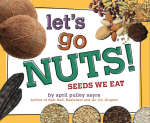 Studying seeds and plant life? Working on nutrition or ecology in preschool through second grade? I hope this will help. My newest book, Let’s Go Nuts! Seeds We Eat was released this week by my marvelous publisher, Beach Lane, an imprint of Simon & Schuster. It’s a chant but with lots of, should we say, chewy endmatter. Once I started working on this book even I was amazed by just how many foods we eat are made from seeds. Just check out the pantry. Corn. Wheat. Lentils. Almonds. Soy milk. Popcorn. Pumpkin seeds. I’m still eating some of the dried beans that made up the photos in the book. It was photographed at the South Bend Farmer’s Market, Bamber’s Superette, Saigon Market, and other local food spots, including Notre Dame University’s South Dining Hall!
Studying seeds and plant life? Working on nutrition or ecology in preschool through second grade? I hope this will help. My newest book, Let’s Go Nuts! Seeds We Eat was released this week by my marvelous publisher, Beach Lane, an imprint of Simon & Schuster. It’s a chant but with lots of, should we say, chewy endmatter. Once I started working on this book even I was amazed by just how many foods we eat are made from seeds. Just check out the pantry. Corn. Wheat. Lentils. Almonds. Soy milk. Popcorn. Pumpkin seeds. I’m still eating some of the dried beans that made up the photos in the book. It was photographed at the South Bend Farmer’s Market, Bamber’s Superette, Saigon Market, and other local food spots, including Notre Dame University’s South Dining Hall!
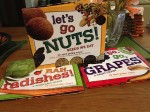 It completes the trio of books that includes Rah, Rah, Radishes: a Vegetable Chant and Go, Go, Grapes: a Fruit Chant. You’ll find lots of activities related to those first books here on my site. Do let me know about what you creative educators do with edible seeds! Here are a few seed resources to get you started.
It completes the trio of books that includes Rah, Rah, Radishes: a Vegetable Chant and Go, Go, Grapes: a Fruit Chant. You’ll find lots of activities related to those first books here on my site. Do let me know about what you creative educators do with edible seeds! Here are a few seed resources to get you started.
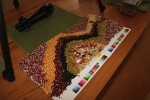 Here’s a photo of me working on the final spread for the book. I used an old galley from Go, Go, Grapes to measure how big I needed my seed picture to be. By the way, no seeds were wasted. After the photo I slid the seeds into a bowl then while I watched TV I sorted all those seeds back into jars. No joke. Did that many, many times after photo shoots. Nothing wasted. Some leftover seeds were used by the fabulous Unity Gardens folks.
Here’s a photo of me working on the final spread for the book. I used an old galley from Go, Go, Grapes to measure how big I needed my seed picture to be. By the way, no seeds were wasted. After the photo I slid the seeds into a bowl then while I watched TV I sorted all those seeds back into jars. No joke. Did that many, many times after photo shoots. Nothing wasted. Some leftover seeds were used by the fabulous Unity Gardens folks.

Let’s Go Nuts! Seeds We Eat is a chant which introduces children to beans, nuts, grains, and spice seeds. Endmatter explains why seeds don’t grow inside our stomachs, why seeds are such great food, and how seeds fit into biology, ecology, and culture. This book completes the trio of books that includes Rah, Rah, Radishes: A Vegetable Chant and Go, Go, Grapes: a Fruit Chant.
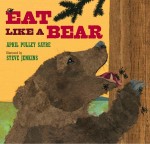 Eat Like a Bear, my book illustrated by Steve Jenkins and published by Henry Holt, just received a starred review in Publisher’s Weekly. Kirkus reviews also gave it a starred review. I’m excited that folks “get” this book. I was so pleased with every word, illustration, design choice on this project. It was a great team effort. Tilt the cover and check out the shiny ants. Notice the designer’s great backmatter fonts and layout. See a few pages on Henry Holt’s website. Okay, so I’m a little stoked about it. Guess what else thrills me: Steve Jenkins has signed on to illustrate my next three books with Henry Holt! Need I say more? Yes. Another Steve Jenkins book, one which he wrote, The Animal Book, received a starred review in PW this week. Go, Steve!
Eat Like a Bear, my book illustrated by Steve Jenkins and published by Henry Holt, just received a starred review in Publisher’s Weekly. Kirkus reviews also gave it a starred review. I’m excited that folks “get” this book. I was so pleased with every word, illustration, design choice on this project. It was a great team effort. Tilt the cover and check out the shiny ants. Notice the designer’s great backmatter fonts and layout. See a few pages on Henry Holt’s website. Okay, so I’m a little stoked about it. Guess what else thrills me: Steve Jenkins has signed on to illustrate my next three books with Henry Holt! Need I say more? Yes. Another Steve Jenkins book, one which he wrote, The Animal Book, received a starred review in PW this week. Go, Steve!
Good review of Turtle, Turtle, Watch Out! and related books in and Ocean Alive Section of Family magazine and also on the website of reviewer Meribeth Shank. Hooray! Nice to be in good company.
View Next 25 Posts
































